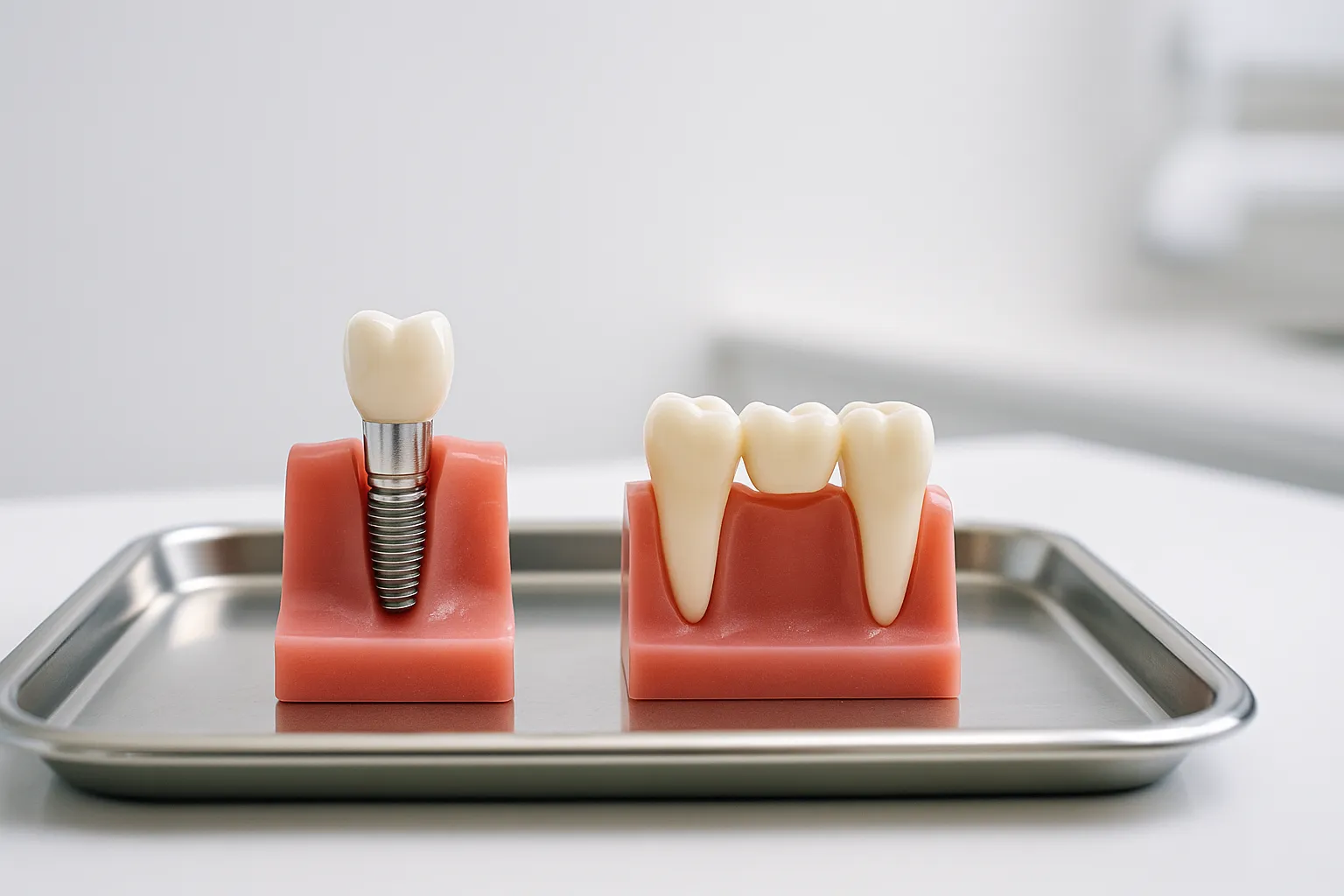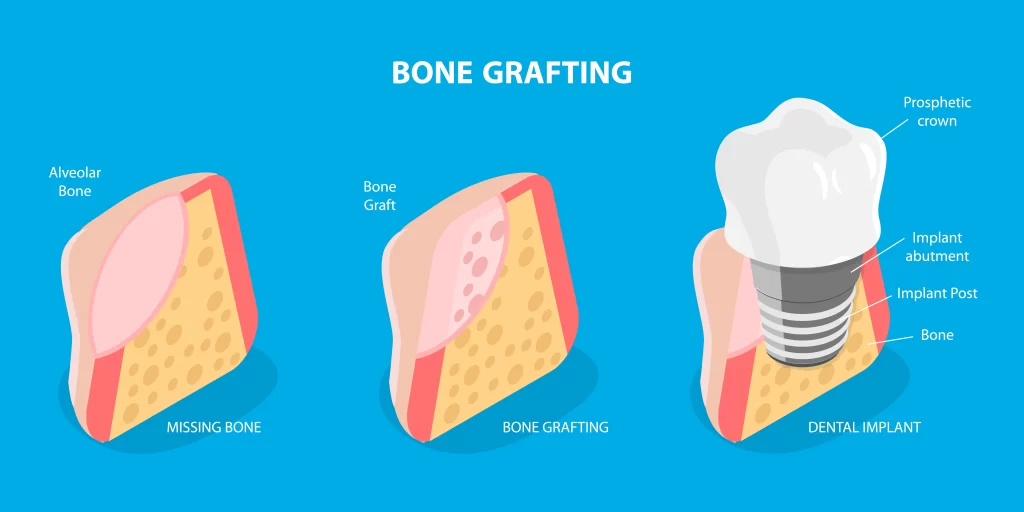Tooth Implant vs Dental Bridge

When a tooth is missing, two proven options restore appearance and function. A dental implant places a titanium post into the jaw to act as an artificial root for a crown. A dental bridge spans the gap with a prosthetic tooth supported by crowns on the neighbouring teeth.
Implants tend to offer greater long-term stability and help preserve bone, while bridges avoid surgery and can be completed sooner. The right choice depends on bone volume, oral health, budget, timeline, and aesthetic goals.
What each option involves and how they compare
Dental implants are placed surgically, then restored with a crown once healing has occurred. They do not rely on adjacent teeth.
Dental bridges are tooth-supported. Crowns on the neighbouring teeth anchor a prosthetic tooth to bridge the space.
Key advantages and drawbacks at a glance
- Implants advantages
- Long-term stability and strong bite function
- Helps limit ongoing bone loss in the gap
- No reshaping of neighbouring teeth
- Implants drawbacks
- Higher upfront cost
- Requires a surgical procedure and healing time
- Bridges advantages
- Quicker to complete with no surgery
- Useful when adjacent teeth already need crowns
- Bridges drawbacks
- Requires reshaping of supporting teeth
- Typical replacement interval is about 10 to 15 years
- Does not prevent bone loss beneath the gap
When bone grafting is needed and likely costs

Implants rely on sufficient bone for predictable osseointegration. If CBCT imaging shows a ridge that is too narrow or low for stable implant placement, grafting is commonly advised to rebuild width or height. A history of periodontitis raises the likelihood of grafting.
Common grafting materials
- Autograft your own bone, for example, from the chin or hip
- Allograft sterilised donor bone
- Xenograft bovine-derived mineral
- Alloplast synthetic substitutes, such as calcium phosphate
Indicative fees vary with material and volume. For consumer fee context, review the cost of dental care and confirm whether minor grafts are included in the implant quote. For plain language procedure context, see the practice guide to dental bone grafts.
Procedure timelines and what to expect
Implant workflow typical sequence
- Clinical assessment, CBCT, and digital planning
- Surgical placement of the fixture
- Healing and integration often take 3 to 6 months
- Final abutment and crown
Bridge workflow typical sequence
- Preparation and impressions or scanning of the supporting teeth
- Temporary bridge during the laboratory phase
- Fit and cementation of the definitive bridge
Factors that guide a tooth replacement choice
Number and position of missing teeth
Single or non-adjacent gaps often favour implants, while consecutive gaps may be efficiently restored with a multi-unit bridge.
Oral health and bone quality
Healthy gums and adequate bone support implant success. Compromised abutments can tilt the balance towards a bridge.
Budget and timing
Bridges are faster and usually cheaper initially. Implants often prove more cost-effective over time due to longevity and independence from adjacent teeth.
Aesthetic goals and personal preference
Some people prioritise the tooth-like feel of implants, while others value the speed and simplicity of a bridge. Discuss visible gum contours, smile line, and soft tissue thickness during planning.
Options when bone is limited
Some jaws remain too narrow or lack height even after grafting. Two specialised solutions may help.
Mini implants narrow-diameter fixtures
- Often used to stabilise dentures or narrow ridges
- Less invasive surgery and quicker healing
- Lower bite force tolerance, commonly transitional or for overdentures
Zygomatic implants for severe upper jaw bone loss
- Anchored in the cheekbone to bypass the deficient upper jawbone
- Can reduce the need for sinus lifts or large grafts
- Requires advanced surgical expertise and careful case selection
- Read more about candidacy for zygomatic implants
Materials for implant-supported teeth: titanium vs zirconia
Titanium remains the workhorse for strength and long-term data. Zirconia, a high-strength ceramic, is tooth coloured and metal-free, which is useful in thin gum biotypes.
- Titanium has extensive decades-long evidence and very robust performance, but a grey hue may show through thin gums
- Zirconia tooth coloured and metal-free free with growing evidence, and typically a 10 to 20 percent premium
If a conventional bridge is under consideration, see how crowns and bridges are planned and maintained to compare like-for-like effort and upkeep.
Maintenance that maximises lifespan
Consistent hygiene and reviews extend the life of both implants and bridges.
Home care
- Brush twice daily using a soft or electric brush
- Clean beneath bridge pontics and around implants with interdental brushes or floss threaders
- Use a non alcoholic antiseptic rinse if recommended
Professional maintenance
- Bridges – six-monthly hygiene visits to clean, polish, and check abutments
- Implants – reviews every 4 to 6 months for soft tissue assessment and debridement to reduce peri-implantitis risk
Long-term outcomes supported by evidence
Long-term studies show high predictability for modern implant systems. A multi-decade follow-up indexed on PubMed reports cumulative implant survival of roughly 95.6 percent over about 38 to 40 years for endosseous fixtures. Conventional porcelain-fused-to-metal bridges typically last 10 to 15 years, with a substantial proportion still serviceable at 15 years when hygiene and occlusion are well managed.
Comfort and anxiety management
Modern protocols keep appointments comfortable and calm. Options include local anaesthetic for routine steps, mild oral sedation, and IV twilight sedation administered by an anaesthetist. If you are exploring options, this overview of conscious sedation explains how visits are planned and monitored.
Temporary solutions while treatment is underway
Short-term options preserve appearance and function until the final restoration is ready.
- Essix retainer – a clear tray with an integrated pontic, discreet but not for heavy chewing
- Flipper – an acrylic partial denture clipped to adjacent teeth, more robust yet still temporary
Digital planning and how the practice can help

Accurate planning improves outcomes. Intraoral scanning provides precise digital models, CBCT maps bone and anatomical structures in 3D, smile design software previews tooth position, and 3D printed surgical guides help place fixtures exactly as planned. Within this workflow, Dr. Bobby Chhoker and the team can deliver a comprehensive assessment, implant or bridge, CBCT-led planning, guided surgery where appropriate, sedation choices for anxious patients, well-timed temporaries, and a structured hygiene programme to protect the long-term result.
Final thoughts
Choosing between an implant and a bridge comes down to bone quality, the condition of neighbouring teeth, treatment time, maintenance commitments, and long-term value for your mouth. To move forward with confidence:
- Book a comprehensive assessment, including a clinical exam and appropriate imaging
- Bring any recent X-rays and your health fund details
- Ask three practical questions
- Do I have enough bone for an implant without grafting
- What lifespan is realistic in my case, and why
- What maintenance schedule will keep the result stable
For a clear, personalised plan aligned to your goals and budget, arrange a consultation with Dr. Bobby Chhoker to map the option that best supports stable function, healthy tissues, and natural aesthetics.
